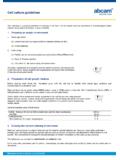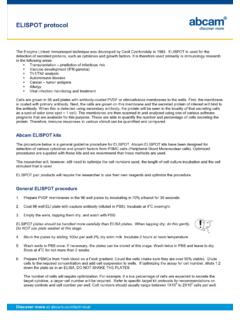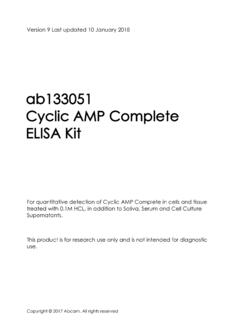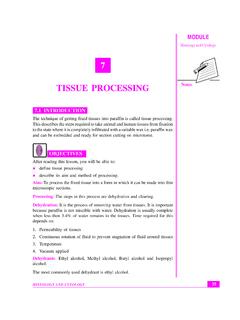Transcription of IHC-PARAFFIN PROTOCOL (IHC-P) - Abcam
1 IHC-PARAFFIN PROTOCOL (IHC-P) Immunohistochemistry (or IHC) is a method for demonstrating the presence and location of proteins in tissue sections. Though less sensitive quantitatively than immunoassays such as Western blotting or ELISA, it enables the observation of processes in the context of intact tissue. This is especially useful for assessing the progression and treatment of diseases such as cancer. In general, the information gained from IHC combined with microscopy literally provides a big picture that can help make sense of data obtained using other methods. Immunohistochemical staining is accomplished with antibodies that recognize the target protein. Since antibodies are highly specific, the antibody will bind only to the protein of interest in the tissue section.
2 The antibody-antigen interaction is then visualized using either chromogenic detection, in which an enzyme conjugated to the antibody cleaves a substrate to produce a colored precipitate at the location of the protein, or fluorescent detection, in which a fluorophore is conjugated to the antibody and can be visualized using fluorescence microscopy. IHC-P refers to the staining of tissues that have been fixed (usually in neutral buffered formalin) and then embedded in paraffin before being sectioned. The basic steps of the IHC-P PROTOCOL are as follows: 1. Fixing and embedding the tissue 2. Cutting and mounting the section 3. Deparaffinizing and rehydrating the section 4. Antigen retrieval 5. Immunohistochemical staining 6. Counterstaining (if desired) 7.
3 Dehydrating and stabilizing with mounting medium 8. Viewing the staining under the microscope A. Optimizing a new antibody for IHC-P 1. Antigen retrieval 2. Primary antibody concentration 3. Detection B. Fixation C. Deparaffinization D. Antigen retrieval 1. Buffer solutions for heat-induced epitope retrieval 2. Heat-induced epitope retrieval methods 3. Enzymatic antigen retrieval E. Immunohistochemical staining 1. General guidelines 2. PROTOCOL 3. Controls 4. Signal amplification F. Resources G. Additional buffer recipes A. Optimizing a new antibody for IHC-P When using a new antibody in IHC-P, the antibody must be tested to find the optimal staining conditions. Each antigen has a preferred method of antigen retrieval, and each antibody has an optimal dilution.
4 1. Antigen retrieval Try staining without antigen retrieval, and also using the following antigen retrieval methods. Detailed protocols for these procedures are in the Antigen Retrieval section. Heat-induced: Sodium citrate 10 mM, pH Heat-induced: Tris/EDTA pH Enzymatic: trypsin, pepsin, or other protease Once the optimal antigen retrieval method is established, the antibody concentration can be fine-tuned. 2. Primary antibody concentration If the concentration of the antibody is provided, we recommend trying g/ml and 5 g/ml overnight at 4 C. If the antibody is unpurified, we recommend starting with the following starting dilutions, and also testing a 20-fold higher dilution. Whole antiserum: 1/50 Ascites: 1/100 Tissue Culture supernatant: undiluted (also referred to as neat ) 3.
5 Detection We recommend horseradish peroxidase (HRP) for visible light microscopy. Peroxide/DAB are the substrate and recommended chromogen for horseradish peroxidase. Various fluorochrome-conjugated antibodies are available for fluorescent microscopy; choice will dictated by the needs of the experiment. B. Fixation Proper fixation is key for the success of neutral buffered formalin (NBF) is most commonly used. Where Abcam s datasheets state IHC-P as a tested application, this fixative has been used unless stated otherwise. Other fixatives such as paraformaldehyde (PFA) or Bouin solution (formalin/picric acid) are used less frequently. The ideal fixation time will depend on the size of the tissue block and the type of tissue, but fixation between 18-24 hours seems to be ideal for most applications.
6 Under-fixation can lead to edge staining, with strong signal on the edges of the section and no signal in the middle; over-fixation can mask the epitope. Antigen retrieval can help overcome this masking, but if the tissue has been fixed for a long period of time ( over a weekend), there may be no signal even after antigen retrieval. After fixation, the tissue block is embedded in paraffin , then cut in a microtome to the desired thickness (approximately 5 microns is ideal for IHC) and affixed onto the slide. Tissue sections are best mounted on positively charged or APES (amino-propyl-tri-ethoxy-silane) coated slides. Once mounted, the slides should be dried to remove any water that may be trapped under the section. This can be done by leaving the slide at room temperature overnight.
7 If there is a problem with the section adhering to the slide, you may also incubate the slide at 60 C for a few hours. C. Deparaffinization Before proceeding with the staining PROTOCOL , the slides must be deparaffinized and rehydrated. Incomplete removal of paraffin can cause poor staining of the section. Materials and reagents Xylene 100% ethanol 95% ethanol Method Place the slides in a rack, and perform the following washes: 1. Xylene: 2 x 3 minutes 2. Xylene 1:1 with 100% ethanol: 3 minutes 3. 100% ethanol: 2 x 3 minutes 4. 95% ethanol: 3 minutes 5. 70 % ethanol: 3 minutes 6. 50 % ethanol: 3 minutes 7. Running cold tap water to rinse Keep the slides in the tap water until ready to perform antigen retrieval.
8 At no time from this point onwards should the slides be allowed to dry. Drying out will cause non-specific antibody binding and therefore high background staining. D. Antigen retrieval Most formalin- fixed tissue requires an antigen retrieval step before immunohistochemical staining can proceed. This is due to the formation of methylene bridges during fixation, which cross-link proteins and therefore mask antigenic sites. The two methods of antigen retrieval are heat-mediated (also know as heat-induced epitope retrieval, or HIER) and enzymatic. Both antigen retrieval methods serve to break the methylene bridges and expose the antigenic sites in order to allow the antibodies to bind. Some antigens prefer enzymatic to heat mediated antigen retrieval and vice versa.
9 Enzymatic retrieval can sometimes damage the morphology of the section, so the concentration and treatment time need to be tested. Antigen retrieval with Tris/EDTA pH buffer is suitable for most antigens. Sodium citrate pH is also widely used. Please see for an explanation of why Abcam recommends using Tris/EDTA pH buffer before sodium citrate pH Heat-induced epitope retrieval is most often performed using a pressure cooker, a microwave, or a vegetable steamer. Additionally, some labs will use a water bath set to 60 C and incubate the slides in retrieval solution overnight. Unless the antigen retrieval method is stated on the antibody datasheet, the optimal method for each antigen must be found experimentally. Abcam recommends testing several methods to find the retrieval that gives optimal staining.
10 1. Buffer solutions for heat-induced epitope retrieval The following solutions are three of the more popular buffers for HIER. In the absence of advice from other researchers for a particular antibody, choice of retrieval buffer is best accomplished by experiment. Sodium Citrate Buffer (10mM Sodium Citrate, Tween 20, pH ) Tri-sodium citrate (dihydrate) g Distilled water 1000 ml Mix to dissolve. Adjust pH to with 1N HCl. Add ml of Tween 20 and mix well. Store at room temperature for 3 months or at 4C for longer storage. 1 mM EDTA, adjusted to pH EDTA g Distilled water 1000 ml Store at room temperature for 3 months. Tris-EDTA Buffer (10mM Tris Base, 1mM EDTA Solution, Tween 20, pH ) Tris g EDTA g Distilled water 1000 ml (100 ml to make 10x, 50 ml to make 20x) Mix to dissolve.










